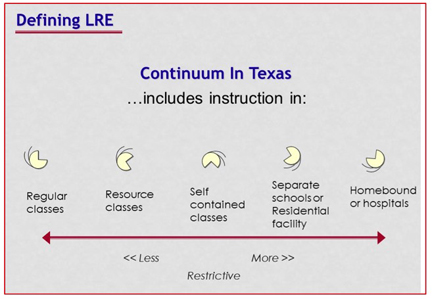en Español • Share • 
You’ve come to the final decision of the ARD committee: Placement. This is often a difficult concept for families to understand. Placement does not indicate where a student goes to work on various IEP goals. Placement refers to the continuum of placements (mainstream, resource, self-contained, homebound, etc.).

In other words, placement is where your child will spend the majority of his/her day at school learning. It might be the regular education classroom, a resource room or possibly a self-contained classroom. Placement decisions are based on IEP goals and where those goals can best be met, with the Least Restrictive Environment always the priority.
What Placement is NOT:
- Placement decisions are NOT based on disability labels (“We have a wonderful program for kids with autism on the Northside campus”.)
- Placement decisions are NOT based on the types of supports needed (“We work with all the non-verbal kids in the Pre-K room” or “The life-skills classroom is the best place for kids with these kinds of needs” or “Kids with behavior problems go to Ms. Smith’s class” or “If your child needs an aide, they need to be in the resource or life skills class”).
- Placement decisions are NOT based on what the parent wants or what a school professional wants for the child (“Our school only has a self-contained classroom; we don’t have resource” or “My child could never be included - I want my child to be in a special classroom” or “His wheelchair is too big for the regular education classroom”).
- Placement decisions should NOT guide the development of the IEP Goals & Objectives (“He is going to be in self-contained so we will develop only functional goals” or “She is going to go to XYZ campus and they will only work on life skills there”). Placement decisions should be made AFTER goals and objectives, based on the needs of the student, have been developed.
Once the ARD committee has formulated a list of IEP goals and reviewed supplementary aids and services to be provided, it will use those same goals and services to make placement decisions. Use the Placement Matrix to help make decisions surrounding goals, services to be provided, and placement.
What is placement then?
So what does this mean? If placement is not about “where” the child is going to work on his or her goals – why do we use the Placement Matrix? Once you map out all the goals and support services on the matrix, the ARD committee will be able to see what percentage of the day the student’s instructional arrangement is “outside” of the regular education classroom.
If all special education supports and related services are provided within the general education classroom during the whole day, then the placement, or instructional arrangement, would be “mainstream”. If your child receives supports and services outside of the general education setting, the percentage of the day will determine the “placement in the LRE”. See also Instructional Arrangements.
Provided, Tried, and Considered
If the ARD committee decides that a student needs to receive their special education or related services outside the general education setting, the ARD committee must document and describe:
- Any previous efforts to educate the student in the general education classroom with supplementary aids and services and why those efforts were not successful;
- Any consideration of educating the student in the general education classroom and why those options were rejected;
- The behavior management plan and why it cannot be implemented in the general education classroom;
- The methods or curriculum the student needs and why it cannot be implemented in the general education classroom; and
- The disability conditions and educational needs and why those conditions and needs require placement in other than the general education classroom.
As the ARD committee considers placement, it must think about possible harmful effects as well as potential positive effects that a placement could have on the child. If the committee decides to remove the child from a regular classroom setting, it must ensure that, whenever appropriate, the child will be with other kids who are in regular classes.
One last consideration: Your child must be educated in the school she would attend if she did not have a disability, typically called your “neighborhood school.” If the IEP goals require a different placement other than the neighborhood school, the ARD committee must document the specific supplementary aids and services that were considered or tried to support the student on the home campus and why those services/aids were rejected.
As you and the ARD committee consider placement, be sure to keep an eye on the future. Where do you envision your child as an adult? Remember that whatever environment you create for your child when he is young, you must be prepared to replicate that same environment in the adult world.
Have high expectations and place your child in the settings that most encourage those high hopes!
Progress in the General Curriculum (ESC 20) has created the Least Restrictive Environment Question and Answer document that can help you understand placement.




